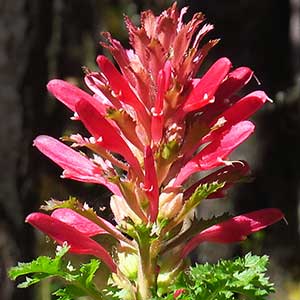Pedicularis densiflora
Pedicularis contorta
Indian warrior, warrior's plume
coil-beak lousewort, coiled lousewort, coiled pedicularis, curve-beak lousewort, curved-beak lousewort, white coiled-beak lousewort
basal 1–10, blade lanceolate, 30–200 x 20–70 mm, 2(or 3)-pinnatifid, margins of adjacent lobes nonoverlapping or extensively overlapping distally, 1-serrate, surfaces glabrous, hispid, or downy;
cauline 4–20, blade lanceolate, 15–250 x 5–100 mm, 2-pinnatifid, margins of adjacent lobes nonoverlapping or extensively overlapping distally, serrate, surfaces glabrous, hispid, or downy.
basal 3–10, blade lanceolate, 30–100 x 5–30 mm, 1- or 2-pinnatifid, margins of adjacent lobes nonoverlapping, entire or serrate, surfaces glabrous;
cauline 2–10, blade elliptic or triangular to lanceolate, 5–70 x 10–25 mm, 1-pinnatifid, margins of adjacent lobes nonoverlapping, entire or serrate, surfaces glabrous.
simple, 1–5, exceeding basal leaves, each 10–50-flowered;
bracts lanceolate to trullate, 10–35 x 3–5 mm, undivided or 1-pinnatifid, proximal margins entire, distal 1- or 2-serrate, surfaces glabrous.
simple, 1–6, exceeding basal leaves, each 12–40-flowered;
bracts trullate to obtrullate, 5–18 x 2–15 mm, pinnatifid, margins entire, surfaces glabrous.
2–4 mm.
1.5–5.5 mm.
calyx 9–18 mm, downy to tomentose, lobes 5, triangular, 3–4 mm, apex entire, ciliate;
corolla 23–43 mm, tube dark red, purple, or orange-yellow, rarely white, 8–18 mm;
galea dark red, purple, or orange-yellow, rarely white, 15–25 mm, beakless, margins entire medially and distally, apex straight;
abaxial lip dark red, purple, or orange-yellow, rarely white, 8–15 mm.
calyx 5–9 mm, glabrous, lobes 5, triangular, 1–3 mm, apex entire, glabrous;
corolla 7–13 mm, tube white or cream to yellowish or pink to pinkish purple, 4–7 mm;
galea white or cream to yellowish with purple spots at base, or pink to pinkish purple, 2–5.5 mm, beaked, beak coiled, 5–9 mm, base curving, margins entire medially and distally, apex surrounded by abaxial lip, axis of coil nearly vertical;
abaxial lip surrounding beak, white or cream to yellowish, or pink to pinkish purple, 5–8 mm.
= 16.
Pedicularis densiflora
Pedicularis contorta
Scarlet corollas with an undomed, toothless galea and two- or three-pinnatifid leaves are diagnostic of Pedicularis densiflora. This species occurs in forested subalpine regions of southern Oregon, western slopes of the Sierra Nevada, and the Coast Ranges of California south to Baja California. Herbarium records indicate northern populations of P. densiflora occur at higher elevations than do more southern populations.
(Discussion copyrighted by Flora of North America; reprinted with permission.)
Varieties 3 (3 in the flora).
The coiled beak that extends directly downward from the top of the galea is distinctive in Pedicularis contorta. Seen from the side, the large, upward-expanded, lateral lobes of the abaxial lip surround the beak, concealing it from view. The flowers of P. contorta are very similar to those of P. racemosa; however, the leaves of P. racemosa are undivided, the beak curves down and to one side, and the inflorescence often branches, forming a panicle of short racemes with long internodes between flowers.
Flower and calyx color and width of the subtending floral bracts delimit three varieties in Pedicularis contorta; corolla color is difficult to discern in herbarium specimens. The following key is adapted from R. N. Reese (1984).
(Discussion copyrighted by Flora of North America; reprinted with permission.)
1. Corolla tubes, galeas, and abaxial lips white or cream to yellowish, galeas with purple spots at base; calyces pale green. | var. contorta |
1. Corolla tubes, galeas, and abaxial lips pink to pinkish purple; calyces green or reddish with purple spots. | → 2 |
2. Calyces green; bracts 5–8 mm wide, proximal margins ciliate. | var. ctenophora |
2. Calyces reddish with purple spots; bracts 2–4 mm wide, proximal margins glabrous. | var. rubicunda |
- Local floras:
BC,
CA,
OR,
WA
- Local Web sites:
CalFlora,
CalPhotos,
Flora NW,
PNW Herbaria,
Turner Photog.
WildflowerSearch
iNaturalist (observations)
USDA Plants Database
- LBJ Wildflower Center
- SEINet
- Plants of the World Online
- Encyclopedia of Life
- Wikipedia
- Google Image Search


